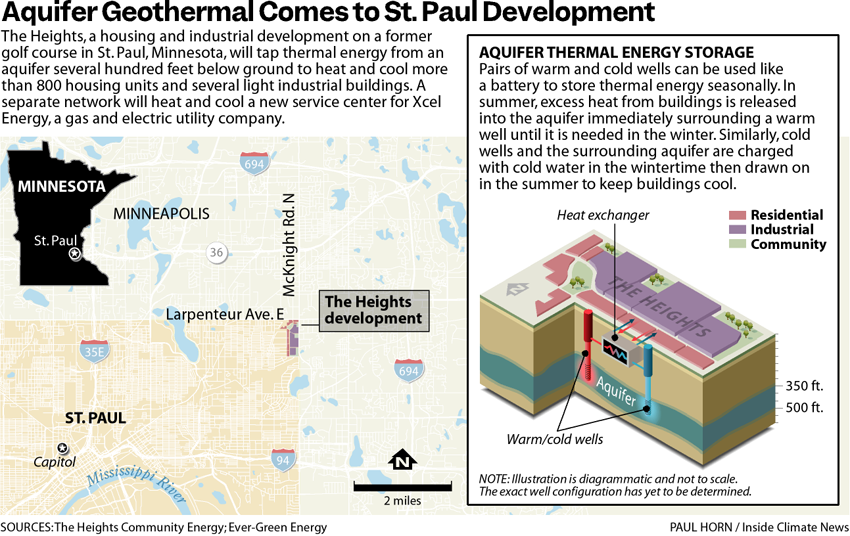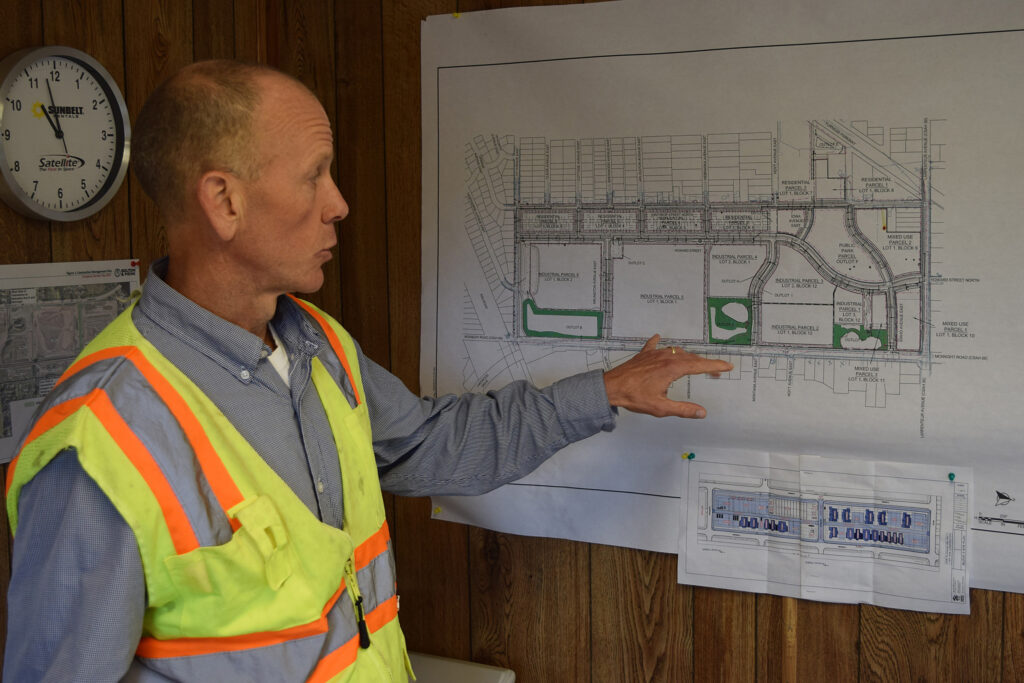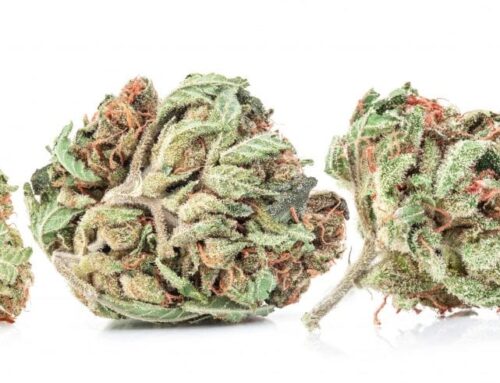Decades After the U.S. Government Conducted Research Beneath This City, a Promising Clean
November 15, 2025
ST. PAUL, Minn.—Nearly half a century ago, the U.S. Department of Energy launched a clean energy experiment beneath the University of Minnesota with a simple goal: storing hot water for months at a time in an aquifer several hundred feet below ground.
The idea of the so-called seasonal thermal energy storage was to tuck away excess heat produced in summer, then use it in the winter to warm buildings.
Now, 45 years after the first test wells were drilled under the university’s St. Paul campus, one of the first large-scale aquifer thermal energy systems in the nation is being built less than 10 miles from the original test site.
The Heights, a mixed-use development rising from a former golf course on the city’s Greater East Side, will tap thermal energy from an aquifer 350 to 500 feet below ground. Groundwater drawn from wells spread across the northern half of the 112-acre development, coupled with high-efficiency electric heat pumps powered in part by solar panels, will provide low-cost heating and cooling with little to no greenhouse gas emissions for 850 homes and several light-industrial buildings.
Get Inside Clean Energy
Today’s Climate
Tuesdays
A once-a-week digest of the most pressing climate-related news, written by Kiley Price and released every Tuesday.
Get Today’s Climate
Breaking News
Don’t miss a beat. Get a daily email of our original, groundbreaking stories written by our national network of award-winning reporters.
Get Breaking News
ICN Sunday Morning
Go behind the scenes with executive editor Vernon Loeb and ICN reporters as they discuss one of the week’s top stories.
Get ICN Sunday Morning
Justice & Health
A digest of stories on the inequalities that worsen the impacts of climate change on vulnerable communities.
Get Justice & Health
The U.S. Green Building Council recently designated the project, led by the Saint Paul Port Authority, a LEED Platinum community. That’s the industry group’s highest level of sustainability certification.
The aquifer will provide steady 50-degree temperatures as a starting point for heating in the winter and cooling in the summer. Depending on the specific needs of future tenants, the groundwater could also serve as a thermal battery, storing excess heat in the summer for use in the winter, said Michael Ahern, senior vice president for system development at Ever-Green Energy, the firm designing the heating and cooling system.
The system will be one of the first large-scale aquifer thermal energy projects operating in the United States since the Department of Energy field tests in the 1980s.
Since then, more than 3,000 similar systems have been built worldwide, with the vast majority in the Netherlands, according to a study published last year in the journal Clean Technologies and Environmental Policy. Only two such systems exist in the United States, the study found. Inside Climate News confirmed the existence of a cooling-only system constructed in 2005 at what is now the campus of Stockton University in New Jersey. A second aquifer thermal energy storage system, which provides heating and cooling for one building at Fort Benning, a U.S. Army post in Georgia, was completed in 2015.
Marc Hoyer, a retired scientist who worked for the Minnesota Geological Survey and the University of Minnesota, served as a project manager on the aquifer thermal energy storage tests in St. Paul in the 1980s. The system they were evaluating included temperatures in excess of 212 degrees Fahrenheit, far higher than what is now being proposed for The Heights.
At the time, he and other Survey members took turns sleeping in a trailer next to wells, waking each hour to record temperature and pressure gauge readings as part of their round-the-clock monitoring of the system’s performance.

Seasonal storage promised to “significantly reduce the need to generate primary energy in the United States,” and aquifers were seen as “the most cost-effective approach,” concluded a federal report published in 1991 by what is now known as the Pacific Northwest National Laboratory.
Hoyer, now 82 and living in Maryland, hadn’t tracked aquifer thermal energy storage developments in recent decades. He said it felt good to hear that the technology is drawing renewed attention in the U.S.
“I figured nobody cared about it,” he said.
The LED of Heating and Cooling
Compared to conventional heating and cooling methods, such as gas boilers and air conditioners, aquifer thermal energy storage can significantly reduce greenhouse gas emissions. According to the 2024 study, it can cut emissions by up to 74 percent. That’s an efficiency increase similar to switching from conventional incandescent lighting to light-emitting diodes, or LEDs, according to the Department of Energy.
“This is the LED version of heating and cooling,” said Yu-Feng Lin, director of the Illinois Water Resources Center at the University of Illinois Urbana-Champaign, who did not participate in the 2024 study.
Aquifer-based heating and cooling works similarly to air-source heat pumps, an increasingly common electric technology that relies on outdoor air to warm and cool buildings. The devices are highly efficient. However, when temperatures spike in the summer or plummet in the winter, the fans and compressors used by air-source heat pumps have to work harder, reducing their efficiency when they are needed most.
While the air temperature in Minnesota can swing from the 90s in the summer to single digits in the winter, the aquifer beneath The Heights remains approximately 50 degrees Fahrenheit throughout the year.
“Think about how much energy you are saving there,” said Lin, who is a principal investigator for an international consortium led by the U.S. Geological Survey that develops standards and best practices for thermal energy storage. “A lot of people think about geothermal as just hot lava [and] hot steam that pushes a turbine to generate electricity. That’s not all of geothermal.”
Charging a portion of the aquifer with warm water in the summer can raise its temperature by several degrees, making winter heating even more efficient, Lin said. Cooling other parts of the aquifer with cold water in the winter can also reduce the amount of energy required for air conditioning in the summer, Lin added.
The system is similar to geothermal heating and cooling networks already in use elsewhere in the region, which use layers of rock and sediment as sources and sinks of thermal energy. The main difference is that aquifer geothermal requires far less drilling.
This story is funded by readers like you.
Our nonprofit newsroom provides award-winning climate coverage free of charge and advertising. We rely on donations from readers like you to keep going. Please donate now to support our work.
Plans for The Heights call for six water wells. If the development had used a more conventional geothermal system, it would have needed to drill approximately 500 boreholes to tap the same amount of thermal energy.
“This is a different type of strategy for geo-exchange that limits the amount of space that you need,” said Ever-Green Energy’s Ahern.
The costs for the two approaches are comparable, as the water wells used for aquifer geothermal are larger and significantly more expensive to drill. Aquifer geothermal also requires access to shallow underground aquifers, which don’t exist everywhere but are a good fit for Minnesota, which has an abundance of subsurface water.
“It kind of makes sense to utilize that local resource,” said Rob Thornton, president and CEO of the International District Energy Association, an industry group.
A Local Resource
On a tour of the site in late June, Ahern’s boots sank into soft mud from a recent rainstorm as he walked past survey stakes marking the contours of future streets and buildings.
“This was all just a golf course,” he said as he walked. “You can kind of get a sense of it from the rolling hills.”
Ahern’s Ever-Green Energy is a subsidiary of District Energy St. Paul, a nonprofit utility that operates the largest hot-water district heating system in North America, providing heating and cooling to much of downtown St. Paul.

In 1998, the utility launched Ever-Green to develop and operate similar district heating and cooling systems elsewhere. The company has since helped design, expand or optimize more than two dozen district energy systems nationwide. Ever-Green is increasingly turning to geothermal energy, including aquifer geothermal, and other renewable energy sources to reduce or eliminate greenhouse gas emissions from its heating and cooling networks.
When tasked with designing a net-zero-emissions campus for The Heights, aquifer geothermal emerged as the top choice for both performance and cost, Ahern said.
While the Trump administration is quickly phasing out tax incentives for wind and solar, credits for geothermal projects approved as part of the Inflation Reduction Act remain largely intact. The Heights’ aquifer thermal energy system, including the wells, heat exchangers and pipe network, will cost approximately $12 million to construct. This does not include the heat pumps and other equipment that will go in each building. Federal tax credits should cover approximately 50 percent of the system’s total cost, Ahern said.
For Cheniqua Johnson, a St. Paul city councilmember representing Ward 7, an adjacent neighborhood on the city’s east side, the projected cost savings for residents of The Heights could be significant.
“It is the difference between paying a $200 to $300 per month bill, and less than $100,” said Johnson, who is also treasurer of the Saint Paul Port Authority. “That is what we’re striving for.”
Johnson added that many in her community have simply had their gas or electricity shut off by their utility company because they were unable to pay their bills.


Before Ever-Green Energy drills any wells, the Minnesota Department of Health and the Department of Natural Resources must approve the project. One concern is that the system won’t raise or lower the aquifer’s temperature too much. Higher temperatures, for example, can cause minerals from the surrounding rocks and sediment to dissolve into the groundwater at higher concentrations.
Regulations in the Netherlands, where thermal storage is most developed, limit the temperature range in which groundwater can be heated or cooled to no more than 25 degrees Celsius (77 degrees Fahrenheit ) and no less than 5 degrees Celsius (41 degrees Fahrenheit), according to the 2024 Clean Technologies and Environmental Policy study.
Another potential concern is that if groundwater is exposed to air above the surface, it could become oxygenated, changing the aquifer’s geochemistry.
“The design parameter that you want to focus on is limiting the amount of time that aquifer water is above ground, and limiting or eliminating the risk that you could expose it to the atmosphere,” Ahern said.
Officials at a Minnesota company that drills wells for aquifer thermal energy systems and will oversee well design and construction for The Heights said one way they have solved this problem is by placing their heat exchangers directly into the wells.
“All of the water stays in the ground,” said Dan King, the chief technology officer at Darcy Solutions, an aquifer geothermal energy startup based in St. Paul. “It never is brought to the surface.”
King said his company, which grew out of the University of Minnesota’s geology department, learned from the early work on aquifer thermal storage in St. Paul in the 1980s.
Darcy Solutions is currently overseeing well drilling for a separate geothermal system at The Heights, which will provide heating and cooling for a new service center for Xcel Energy, a gas and electric utility that will be the first large employer to move in at the site.
Xcel is one of the largest gas and electric utilities in the country, but the use of natural gas at the new service center will be limited primarily to testing and calibrating equipment the company will use elsewhere, said Kristine Williams, the Saint Paul Port Authority’s chief development officer.
Williams said the geothermal effort there could be a sign of things to come.
“I think that this type of industrial development, while it’s unique today, is what we will see going forward,” Williams said.
About This Story
Perhaps you noticed: This story, like all the news we publish, is free to read. That’s because Inside Climate News is a 501c3 nonprofit organization. We do not charge a subscription fee, lock our news behind a paywall, or clutter our website with ads. We make our news on climate and the environment freely available to you and anyone who wants it.
That’s not all. We also share our news for free with scores of other media organizations around the country. Many of them can’t afford to do environmental journalism of their own. We’ve built bureaus from coast to coast to report local stories, collaborate with local newsrooms and co-publish articles so that this vital work is shared as widely as possible.
Two of us launched ICN in 2007. Six years later we earned a Pulitzer Prize for National Reporting, and now we run the oldest and largest dedicated climate newsroom in the nation. We tell the story in all its complexity. We hold polluters accountable. We expose environmental injustice. We debunk misinformation. We scrutinize solutions and inspire action.
Donations from readers like you fund every aspect of what we do. If you don’t already, will you support our ongoing work, our reporting on the biggest crisis facing our planet, and help us reach even more readers in more places?
Please take a moment to make a tax-deductible donation. Every one of them makes a difference.
Thank you,
Search
RECENT PRESS RELEASES
Related Post


